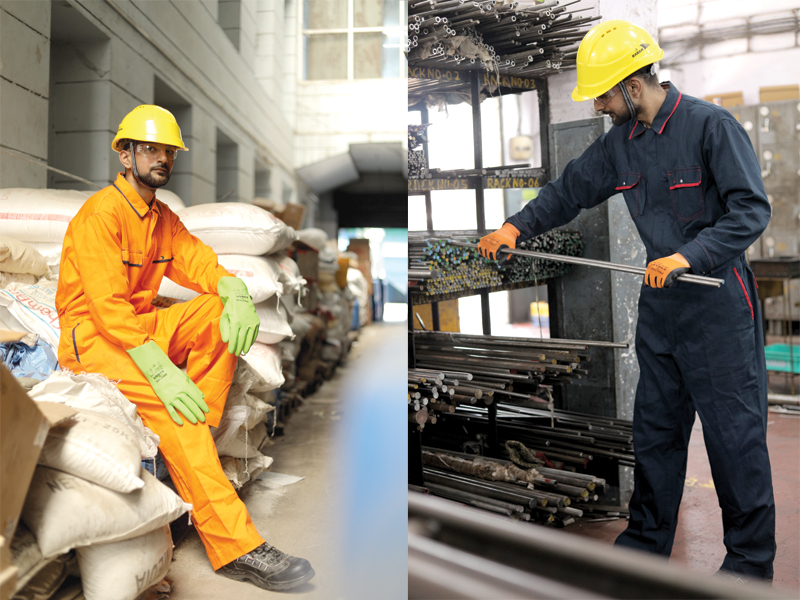
The Unseen Shield: The Importance of Quality Materials in Industrial Coveralls
In the dynamic world of industrial work, where safety and durability are paramount, the significance of quality materials in manufacturing industrial coveralls cannot be overstated. Coveralls are not just garments; they are a shield that protects workers from a myriad of hazards ranging from chemical spills to fire outbreaks. In this blog, we delve into the crucial role that high-quality materials play in the production of coveralls, emphasizing how they contribute to durability and provide a robust defense against potential risks.
Durability Matters
One of the primary reasons why quality materials are essential in the manufacturing of industrial coveralls is durability. Industrial environments can be harsh and demanding, subjecting workwear to wear and tear on a daily basis. Inferior materials can lead to premature deterioration, compromising the protective features of the coveralls and putting workers at risk.
When coveralls are made from top-notch materials, they exhibit enhanced durability. High-quality fabrics and stitching techniques ensure that the garment can withstand the rigors of industrial settings, offering prolonged protection and reducing the frequency of replacements. This not only results in cost savings for businesses but also ensures that workers are consistently shielded from potential hazards.
Protection Against Multiple Hazards
Industrial coveralls serve as a versatile defense mechanism against a wide array of hazards, including chemicals, flames, and abrasions. The choice of materials significantly influences the protective capabilities of these garments. For instance, flame-resistant materials such as Nomex or Kevlar are instrumental in shielding workers from fire-related risks, making them indispensable in environments where combustible materials are present.
Chemical-resistant fabrics, on the other hand, are crucial in industries where exposure to hazardous substances is a constant concern. Quality materials ensure that coveralls provide an effective barrier against chemicals, preventing them from permeating through the fabric and coming into contact with the skin. This multi-hazard protection not only safeguards the well-being of workers but also aligns with stringent safety regulations.
Comfort Enhances Productivity
While the primary purpose of industrial coveralls is to ensure safety, comfort should not be overlooked. Uncomfortable or ill-fitting coveralls can impede the mobility and efficiency of workers, leading to decreased productivity and potential safety risks. High-quality materials not only contribute to the durability and protective features of coveralls but also enhance the comfort level for the wearer.
Breathable fabrics that allow for adequate air circulation, moisture-wicking properties, and ergonomic designs contribute to the overall comfort of the coveralls. Workers in comfortable gear are more likely to perform optimally, and this, in turn, positively impacts the productivity and efficiency of industrial operations.
Resistance to Wear and Tear
In industrial environments, coveralls are subjected to various forms of wear and tear, including abrasions, punctures, and stretching. Quality materials, such as reinforced fabrics or those with high tensile strength, resist these forms of damage, ensuring that the coveralls maintain their integrity over time.
Abrasion-resistant materials, for example, are crucial in industries where workers may come into contact with rough surfaces or sharp objects. By incorporating such materials into the manufacturing process, coveralls become more resilient, offering prolonged protection against physical damage and maintaining their effectiveness in hazardous situations.
Compliance with Standards and Regulations
Quality materials not only enhance the performance of industrial coveralls but also ensure compliance with safety standards and regulations. Regulatory bodies often specify the minimum requirements for protective clothing in different industries. Utilizing substandard materials may result in non-compliance, putting both workers and businesses at risk of legal consequences.
Manufacturers who prioritize the use of high-quality materials can confidently affirm that their coveralls meet or exceed industry standards. This not only instills confidence in the end-users but also establishes the credibility of the brand in the market. Compliance with safety regulations is not just a legal requirement; it is a commitment to the well-being of workers and the overall safety culture within the industry.
In conclusion, the importance of quality materials in the manufacturing of industrial coveralls cannot be emphasized enough. These garments are not mere uniforms; they are a critical line of defense that protects workers from a myriad of hazards. Durability, protection against multiple hazards, comfort, resistance to wear and tear, and compliance with safety standards are all factors that hinge on the quality of materials used.
Investing in high-quality materials for industrial coveralls is an investment in the safety, well-being, and productivity of the workforce. As industries evolve and safety regulations become more stringent, the role of quality materials in ensuring the effectiveness of protective clothing becomes increasingly vital. It’s not just about covering the body; it’s about providing an unseen shield that empowers workers to face the challenges of industrial environments with confidence and resilience.





